
|
||
|
Portland art blog + news + exhibition reviews + galleries + contemporary northwest art
|
||
Gertrude & Otto Natzler at MoCC 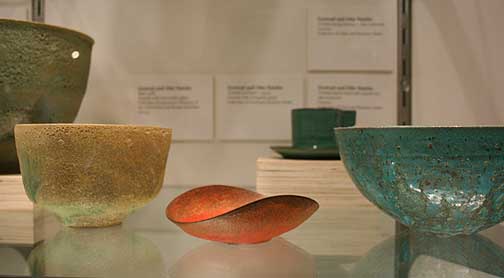 Ceramics by Gertrude and Otto Natzler, photo Jeff Jahn This September plays host to some of Portland's most spectacular, erudite and heavy hitting shows in recent memory but the one I keep coming back to is an oasis of quiet mastery, The Ceramics of Gertrude and Otto Natzler at the Museum of Contemporary Craft. It's a return of sorts since the museum organized a retrospective of the Natzlers in 1975 when MoCC was then called the Contemporary Crafts Gallery. Maybe it's the renewed interest in everything mid 20th century or the way it makes difficult things look so easy with its incredibly rare display of virtuosity. Maybe it is the daunting consistency and experimentation of this husband and wife team who fled the Nazis in 1937 but somehow this feels like the show that must not be missed. 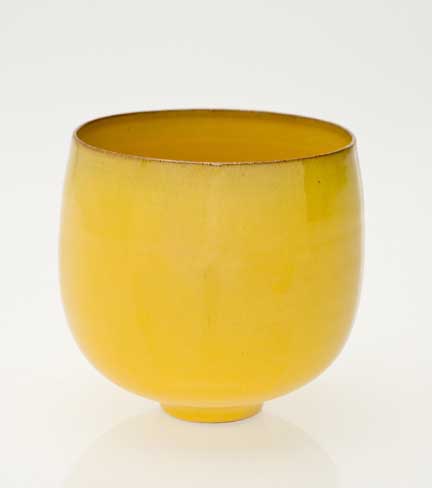 Gertrude and Otto Natzler, Untitled yellow bowl, date unknown, ceramic; 3.5x3.5 inches diameter; Collection of Carol and Seymour Haber, Photo Dan Kvitka Sure, not all ceramics are high art... but just like Ming vases or Greek vessels like the Euphronios Crater, I think many of these make the grade. We should all remember that ceramics, though inherently fragile are also particularly good at surviving the ages. Ceramics are often the bones of a culture. True, plastic water bottles are adept survivors of time as well but the Natzler's work tells us a more elegant, certainly more considered story of human activity. Making a habit of such consideration, this is a refreshingly small show installed in several non-hierarchically formal configurations. Sometimes works are grouped according to color, glazing technique, form or just purely aesthetically pleasing combinations but overall its the lack of didacticism that rings truest here. It's simply a fitting exploration of the Natzler's explorations and the display proves how that alone is enough. Lesser artists often need a crutch. 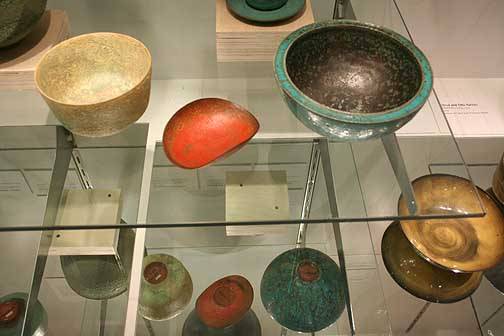 Installation view of ceramics by Gertrude and Otto Natzler, photo Jeff Jahn I particularly appreciate the ability to see the undersides of some of these pieces in mirrors beneath many of the displays... it is sort of like a studio visit with the artists, where aesthetic conceits are revealed as a process. Compared to a lot of contemporary art today the Natzler's work doesn't jump up and down clamoring for attention like a bunch of circus carnies on the midway... maybe the mid 20th century was a more elegant time and its kind of a treat to visit. Also, unlike those sorts of spectacle shows this one doesn't aim to confuse, flatter or ingratiate itself, it simply provokes awe leading us to greater consideration of two of the best sculptors in the past 100 years. They are just that good... and if only 5 of these pieces survived the ages and nothing else it would make our times look more civilized and adventurous than we really deserve to be remembered. I'd love to see the Natzlers on display next to Pollock, Barnett Newman, Clyfford Still, Donald and Sol Lewitt. Maybe a sculpture show with Calder, David Smith, a couple of 60's Ferraris, some Eames furniture and some Yves St. Laurent clothing would make it even clearer... sometimes it's the fringe of functionality that becomes the most poetic examples of the important but irrational ideals of a civilization? 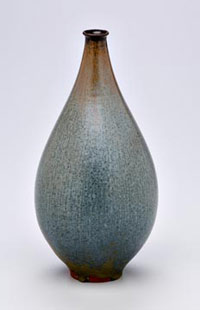 Teardrop Vase, photo Dan Kivitka 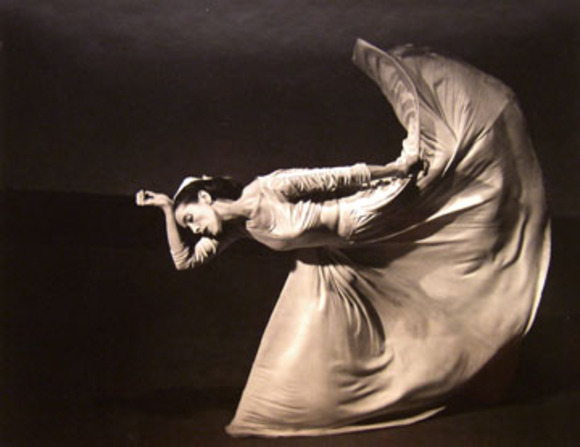 Martha Graham, Letter to The World, "The Kick". 1940. photo Barbara Morgan Maybe it is the palpable intelligence as material that strikes the viewer in this show of works from the late 30's through the 70's... the idea that somebody (much less a team) could regularly produce the physical grace in Gertrude's forms and meld it to uncertainty and control of Otto's glazes for so long. Every single one of these pieces reminds me of Martha Graham's choreography... it looks easy in finished form but it's daunting to get the body or clay to do that. Overall, it demands the kind of thing most contemporary artists seem avoid like the plague, respect. But here it is, in spades... respect and a quest to test the materials as well as the laws of physics. 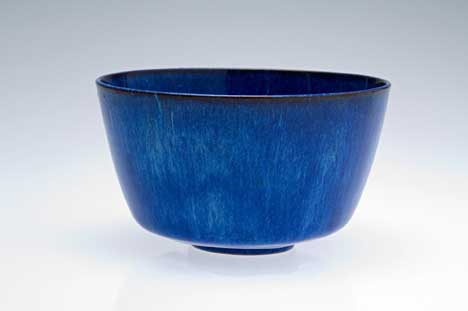 Bright Blue Bowl, 1968; Ceramic; 5.25 x 3 inches diameter; Museum of Contemporary Craft, Gift of Tom Hardy photo Dan Kivitka Take for instance the Natzler's little "Bright Blue Bowl." It terribly fragile yet strong, like an egg. But it contains nothing, no zygote... save the internal space it carves out while claiming a respectful perimeter around itself. It isn't just a bowl; it's an island demarcating a tiny, fragile space. It's an uneasy object of tenuous but earned respect formed in a couple of highly considered minutes in Gertrude Natzler's brilliant hands. Otto Natzler's undulating blue glaze is uniformly varied, a Mandelbrot Set of monochromatically consistent inconsistencies paralleling the surfaces of Abstract expressionist paintings. This piece reminds me a lot of Yves Klein, whose paintings and sculpture used a similar blue applied in a physical manner to evoke a kind of existential grace. Here the Natzlers created an equally graceful object, one which transcends it's functionality (of its performance art element that was its making). 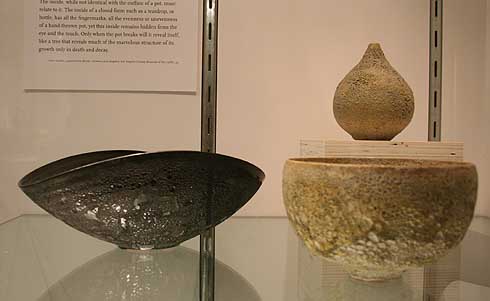 (Left)Otto and Gertrud Natzler, Untitled (Black Crater Elliptical Vessel, 1943), Earthenware with black Crater glaze, Collection of Fine Art Museums of San Francisco, Gift of Dorothy and George Saxe to the Fine Arts Museums Foundation) My favorite pieces in the show all have either Otto's trademark "lava" or "crater" glazes. For example the surface of "Black Crater Elliptical Vessel" from 1943 reminds of the kind of lava called a'a. It is very rough due to all of the gasses that bubble out of it as it flows and when cooled it is called clinkery because it "clinks" like banging ceramics together if you walk on it. You can find it in the McKenzie Pass in Oregon or Hawaii. It also reminds me of Clifford Still's "Monster" painting at the Art Institute of Chicago. The varied black surface has to be viewed from ever changing angles to fully appreciate as light reveals only part of its texture from one vantage point. The important thing is how Otto's glazes never obscure Gertrude's forms. It's an elegant interpersonal detente bourne out in their art. I suspect there were personal moments when this wasn't true but I love the fact that their work is a kind of idealized version of their life together. A contemporary artist like Jessica Jackson Hutchins is exploring similar ideas but from a purposefully clumsier angle. Both have their merits, but one thing is certain the Natzler's ideals are going to stand the test of time. 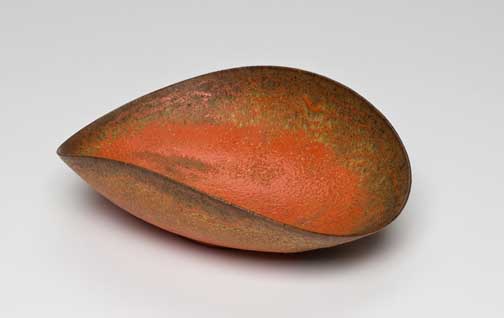 Untitled Oval Bowl, c. 1940 Ceramic with Pompeian glaze; 3.75 x 5 x 1.5 inches; Collection of Carol and Seymour Haber Photo Dan Kvitka Part of the reason the Natzler's work is so timeless is pieces like Untitled Oval Bowl, c. 1940 Pompeian glaze evoke provocative spatial volumes. Sure it's a tiny bowl but its surface and rim recall the craters of volcanoes, something hard wired into the human psyche that denotes good soil as well as danger. Looking at the bowl gives me the same effect as images from James Turrell's as yet unfinished Roden Crater. Turrell is going for macrocosm but somehow the Natzler's evoked that rim of universal experience on the microcosmic level. Will Turrell be as successful, does he understand his own limitations as well as the Natzlers did? Overall its that understanding of the limitations of form, material, surface and collaboration that makes the Natzlers such a treat. It is as elegant as it gets but that's just another byproduct of the respect the work demands. The best forms of respect are always simply a byproduct of mastery and consistent rediscovery, don't miss this show. Through January 25th 2009 Museum of Contemporary Craft Posted by Jeff Jahn on September 13, 2008 at 10:01 | Comments (0) Comments Post a comment Thanks for signing in, . Now you can comment. (sign out)
(If you haven't left a comment here before, you may need to be approved by
the site owner before your comment will appear. Until then, it won't appear
on the entry. Thanks for waiting.)
|
| s p o n s o r s |
 |
 |
 |
 |
 |
 |
 |
 |
 |
 |
 |
 |
 |
 |
 |
 |

|
Site Design: Jennifer Armbrust | • | Site Development: Philippe Blanc & Katherine Bovee | |

